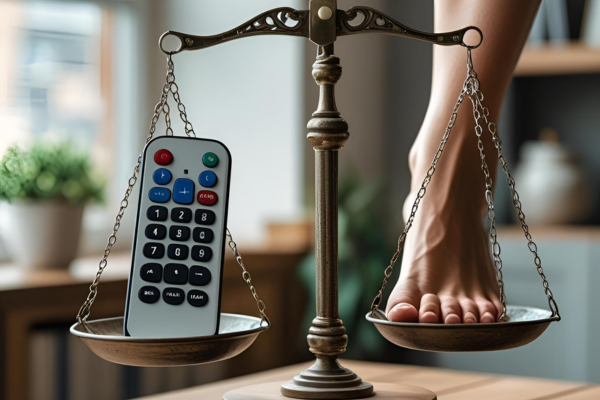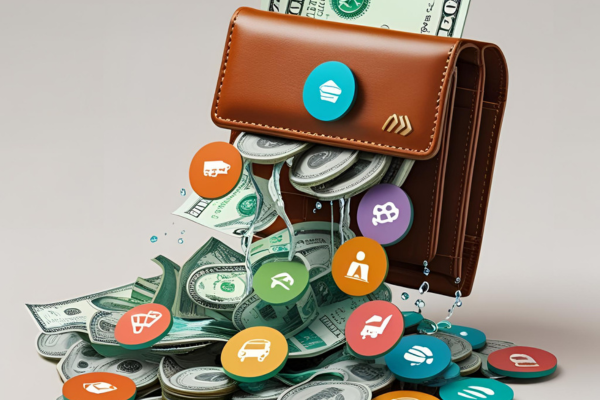Table of Contents
Introduction
I took off my shoes, stretched on the couch, and placed my third delivery order of the week last weekend. Does that sound familiar? Nowadays, the typical American spends 93% of their time indoors, constantly sacrificing comfort for convenience.
The most concerning aspect is that our pursuit of comfort may lead to feelings of misery.
The comfort paradox impacts both our mental and physical well-being. What small comforts do you rely on daily? They are stealthily depriving you of something necessary.
I’ll outline five unexpected ways that comfort is actually harming you in this guide, along with easy changes that strike a balance between ease and growth (without making you take ice baths at five in the morning or sleep on a bed of nails).
The fact that almost everyone falls victim to the third comfort trap on a daily basis astounded me the most.
The Physical Cost of Comfort

A. Sedentary Lifestyle and Its Silent Health Risks
Do you recall our grandparents telling us that they walked five miles to get to school? They were healthier as a result, so they weren’t just boasting.
Modern comfort has deceived us into staying put. Everywhere we go, we drive. We spend hours binge-watching Netflix. To avoid having to walk to the kitchen, we have our food delivered.
The human body did not design this level of inactivity. Your metabolism basically goes to sleep when you sit for long periods of time. Your muscles begin to weaken. Your heart slows down.
The figures are startling:
- Sitting for more than eight hours a day raises the risk of death by 20%.
- Sedentary people are 112% more likely to develop diabetes.
- Bad sitting posture primarily causes 80 percent of Americans to experience lower back pain.
- Long periods of sitting increase the risk of heart disease by 64%.
What’s worse? After spending an hour at the gym, many of us feel good enough to spend the remaining twenty-three hours sitting. Eating one salad and believing it makes up for ten doughnuts is like that.
The subtle nature of the harm is what makes it so pernicious. Today, you won’t feel it. Not tomorrow, perhaps. However, in ten years? Your body will present its bill.
B. How Convenience Foods Sabotage Your Nutrition
The microwave dinner promised to liberate us. Rather, it imprisoned our health.
Convenience foods are designed to maximize profit, have a long shelf life, and have an addictive taste. Did you notice that “nutrition” was absent from that list?
Not only what these foods contain, but also what they lack, is the issue. When was the last time you saw a TV dinner that was full of complex nutrients or vegetables high in fiber?
When convenience becomes your kitchen strategy, the following occurs:
- Your taste buds adjust to anticipate intense flavors (very salty, very sweet).
- Your gut microbiota deteriorates, affecting everything from immune function to mood.
- Your grandmother wouldn’t recognize the chemicals and preservatives you eat as food.
- You lose out on the natural phytonutrients and antioxidants present in fresh foods.
What unnerves us the most? This nutritional theft is costing us a premium. We pay more for the “convenience” of foods that literally shorten our lives, even though a home-cooked meal made with real ingredients is frequently less expensive than processed alternatives.
C. Temperature Control and Weakened Natural Resilience
Our bodies are losing the ability to adapt because we have surrounded ourselves with climate-controlled bubbles.
Consider this: You travel from your air-conditioned house to your air-conditioned vehicle and finally to your air-conditioned workplace. It never takes any effort on your part to control your body’s temperature. It’s similar to not using a muscle.
There are actual repercussions to this constant temperature coddling:
- decreased effectiveness of circulation because your body is unable to adjust blood vessel size in response to temperature
- Immune system weakness brought on by a lack of hormetic stress
- A disturbed metabolism that finds it difficult to burn calories to regulate body temperature
- Enhanced susceptibility to slight variations in temperature
According to research, exposure to a range of temperatures, including mild cold, activates healthy brown fat and increases caloric expenditure. Without altering their diet or exercise routine, Japanese researchers found that subjects who spent two hours a day in a room at 63°F lost belly fat over the course of six weeks.
Our ancestors flourished under various circumstances. Their bodies adjusted as they became hotter and colder. Comfort has come at the expense of our resilience, and our health is suffering as a result.
D. Elevator Culture: When Avoiding Stairs Becomes Harmful
“Why climb when you can ride?” was a strong lift pitch. We are now witnessing the drawbacks of that deal.
Every day, the typical office worker avoids about 1,300 possible stair steps. That’s about 40 calories, which isn’t much on its own, but how much is that over a year? Just from lift habits, that’s 14,600 calories, or roughly 4 pounds of potential weight gain per year.
However, there are additional costs associated with avoiding stairs:
- Cardiovascular conditioning opportunity lost
- Missed opportunity to keep your lower body strong
- abandoned the practice of balance and coordination
- skipped the mental reset and mindfulness period in between tasks.
We’ve normalized using lifts for only one or two floors, which is really crazy. It will literally take us longer to wait for a lift than it would to go up the stairs. As we do this, we lament that we “don’t have time to exercise.”
These days, some progressive firms are creating structures with concealed lifts and noticeable, eye-catching staircases. Why? This is because these firms recognize that small environmental cues encouraging movement positively impact worker productivity and well-being.
To survive, your ancestors scaled mountains. We now argue over whether to take ten steps up.
Mental Stagnation in the Comfort Zone

How Easy Access to Information Reduces Critical Thinking
We used to think our way through problems to find solutions. Do you recall encyclopedias? To find basic facts, you had to comb through volumes. Our brains became stronger as a result of the neural pathways that were developed.
Today? We ask Siri.
How recently have you committed a phone number to memory? or engaged in a discussion about a fact with colleagues instead of immediately searching for it on Google? The instant gratification of information has subtly undermined our capacity for deep thought.
Our minds are becoming indolent. Research indicates that people are less likely to remember information when they are aware that it is readily available online. Technology is outsourcing our mental processes, leading to a phenomenon known as “digital amnesia.”
Losing our ability to make connections and think critically is the true cost, not simply forgetting things. We never sit in that awkward place where true thinking takes place when everything is just a search away.
The Decline of Problem-Solving Skills in Automated Environments
Life has been easier thanks to automation, but at what cost to our cognitive capacities?
Without his phone, I recently witnessed my nephew struggle to figure out a 15% tip. Calculators are taking over basic math skills.
This pattern is present everywhere:
- We never learn spatial awareness because GPS tells us where to go.
- We forget how to spell because autocorrect corrects our spelling.
- Apps for recipes remove the need for cooking improvisation.
Every convenience weakens our ability to solve problems. When systems handle everything, we cease to think and begin to act like operators.
When amusement turns into mental pacification
When Entertainment Becomes Mental Pacification
Netflix recognizes your prolonged engagement with their content and inquires about your continued viewing. The purpose of social media feeds is to keep you scrolling aimlessly. Video games offer just the right amount of difficulty for being engaging without being annoying.
Such activity is mental pacification, not just leisure.
The typical American consumes media for more than eleven hours every day. We are not using that time for introspection, meaningful dialogue, or original thought. Instead of actively participating in our mental lives, we are becoming more at ease with being passive recipients.
The dopamine hits from these simple entertainment sources make it hard to break the cycle. We avoid activities that demand real cognitive effort because we are addicted to the mental comfort.
Use your brain or lose it, just like any other muscle. Mental atrophy follows when entertainment becomes a constant companion.
Financial Drain of Convenience-Based Living

The Hidden Price Tag of Time-Saving Services
We all do it. We could have cooked for Rs80 instead of paying Rs250 for that meal delivery. The wash-and-fold service is three times pricier than doing it yourself. The housekeeping service because “who has time?”
These conveniences have become our default settings and are no longer merely sporadic indulgences. Additionally, they are stealthily depleting our bank accounts.
Consider how much the typical Indian spends each month on convenience services:
Service | Monthly Cost | Annual Cost |
|---|---|---|
Food delivery | Rs1800 | Rs21,600 |
Ride-sharing | Rs1200 | Rs14,400 |
Grocery delivery | Rs55 | Rs6,600 |
Laundry services | Rs800 | Rs9,600 |
Cleaning services | Rs1500 | Rs18,000 |
That’s over Rs70,000 a year just to avoid minor inconveniences!
Subscription Overload: The Cumulative Cost of Comfort
Meal kits, beauty boxes, Netflix, Disney+, Spotify, Amazon Prime, and apps for meditation are just a few examples of the subscription overload.
The subscription economy has perfected the art of making Rs99.99 appear innocuous. However, if you multiply that by seven or eight services, you’ll find yourself losing money without even realizing it.
I recently inquired about a friend’s subscription count. Five or six, she guessed. When did we really count? Fifteen. For services she hardly remembered signing up for, that’s Rs1800 a month, or more than Rs21,000 a year, at an average of Rs120 apiece!
What’s the most significant issue? The majority of people never even use the things they pay for. According to studies, the typical user only utilizes 50% of the features offered by their subscription. For the convenience of not having to make a choice, you are essentially wasting money.
Planned Obsolescence: Paying for the Newest Comfort Features
Do you recall a refrigerator that lasted more than 20 years? We are now replacing “outdated” appliances every five to seven years due to their touchscreens and grocery ordering capabilities, not because they break.
This trend isn’t a coincidence. Businesses purposefully create products with short lifespans or features that become obsolete quickly. When your smartphone isn’t able to run the newest apps, it suddenly feels outdated.
Having the newest, shiniest item is comfortable, but it comes at a high cost. Should you spend Rs12,000 on an additional phone feature? If you replace it every five years rather than every eight, that’s an additional Rs2400 a year.
The Long-Term Cost of Choosing Convenience Over Investment
What’s more shocking is what we lose when we don’t invest the money we spend on convenience.
Think about this: In 20 years, you would have more than Rs 10,00,000 if you invested half of the money you spend on convenience services and received a modest 7% return.
Rather, we are prioritizing short-term comfort over long-term safety. We’re paying for subscription services rather than ownership, ride-sharing rather than dependable transportation assets, and meal delivery rather than cooking abilities.
This convenience-first mentality also permeates more significant choices. renting in a desirable area rather than driving from a reasonably priced house where you could accumulate equity. leasing a fancy car rather than spending money on a dependable car that you could buy outright.
How “Buy Now, Pay Later” Comfort Purchases Create Financial Stress
Is convenience the ultimate trap? The popularity of “buy now, pay later” services has surged significantly.
Indulgence is effortless thanks to these services. When it’s only “four easy payments of Rs7500,” that Rs30,000 exercisemobile phone you don’t need suddenly seems affordable.
The psychology is devastating and brilliant. Your dopamine rush from the purchase has subsided by the time the second payment arrives, but you’re still making payments, frequently at interest rates that would make credit card companies cringe.
According to a recent survey, 45% of BNPL users have made payments they couldn’t afford. An additional 36% stated that their financial anxiety actually increased as a result of these “convenient” payment plans.
The ease of instant gratification produces a delayed discomfort that is far more painful and enduring.
Relationship and Social Consequences

Digital Communication’s Impact on Deep Connection
Do you recall the days when we would unexpectedly knock on a friend’s door? We now text each other, saying, “We should catch up sometime,” but we never do.
We’ve forgotten what true connection feels like because connecting is so simple with our phones. We sacrifice depth for breadth, gaining hundreds of friends on social media while finding it difficult to keep up five deep connections.
The statistics clearly illustrate this point:
- Despite being more “connected” than ever, 65% of people say they feel more alone.
- On average, a person uses their phone 2,617 times every day.
- The majority of text exchanges are shorter than 90 seconds.
When was the last time you witnessed a person’s face change as they dealt with a challenging story you told them? Have you ever felt the solace of an unexpected hug? Instead of using emojis and well-crafted messages, these moments occur in real time and space.
How Comfort Prevents Necessary Conflict Resolution
Tough talks are just that—tough. Thus, rather than ending our relationship, we ghost each other. We communicate via text rather than in person. Rather than resolving conflicts, we unfriend each other.
Avoidance is comfortable, but it leads to relationship debt that grows over time. It eventually becomes due, and typically with interest, just like financial debt.
What we’re losing:
- The ability to disagree constructively
- The closeness that results from resolving conflict
- The development that only occurs when we face challenges
The Decline of Community Engagement Through Convenience
Do you recall the block parties in your neighborhood? Public gardens? Are there any town halls in the vicinity?
These areas are disappearing as we retreat into the convenience of our homes, where everything is readily available, including entertainment and groceries.
The impact on the community is genuine:
- Over the past ten years, volunteer rates have decreased by 23%.
- Sixty-one percent of Americans are unaware of the names of their neighbors.
- Local groups have trouble recruiting new members.
I am sure we would have similar figures in India as well. Though it may not be as high as 61%, it is certainly on the rise, especially in metros. The messy, lovely relationships that make up the social fabric are lost when we contract out community involvement to apps and services. We miss the opportunity to chat with the local restaurant owner because food delivery is so convenient. We never run into our neighbors at the hardware store because online shopping is so convenient.
Not only does our comfort cost us money, but it also costs us each other.
Environmental Impact of Our Comfort Addiction

The Carbon Footprint of Constant Climate Control
Your thermostat settings silently drain the planet.
A carbon-hungry monster is being fed each time you turn up the air conditioning to arctic temperatures in the summer or heat in the winter. For temperature control alone, the typical American home emits roughly 2 tons of CO₂ per year. That’s the same as putting 5,000 miles on your vehicle.
Isn’t that the most concerning aspect? Extreme comfort has become commonplace. Regardless of the weather, we maintain our homes at a perfect 72°F all year long. We expect perfect climate conditions all the time, which would surprise our grandparents.
Simply moving your thermostat 3 degrees closer to the outside temperature can reduce energy consumption by up to 15%. In the winter, wear a jumper indoors. In the summer, use fans. In fact, when you let your body adjust to seasonal changes, it does so more effectively.
Single-Use Convenience Items and Our Planet
Those single-use, “convenient” things? Hidden environmental nightmares.
Products such as paper towels, plastic cutlery, coffee pods, bottled water, and makeup wipes aim to make our lives slightly easier, but they also contribute significantly to waste problems.
A single person’s morning brew with disposable coffee pods generates about five pounds of waste annually. Americans discard 500 million plastic straws daily. They will all outlive your great-grandchildren.
Reusable alternatives offer significant environmental benefits with little effort, which is the unwelcome truth. Even though a basic coffee maker, metal straw, and cloth napkins may take up an additional thirty seconds of your day, they can literally save tons of waste over the course of your lifetime.
Businesses have successfully persuaded us that modern humans find it too difficult to wash a spoon. When you give it some serious thought, it’s ridiculous
Fast Delivery Services: The Hidden Environmental Cost
There is a huge carbon cost associated with that “free” two-day shipping.
You’re effectively saying, “Please consider using more fuel and create more emissions just for my convenience,” when you insist that your new phone case arrive tomorrow. Inefficient routing and half-empty trucks are common during rush deliveries.
The figures are astounding. Rush shipping can have a carbon footprint that is up to 35% greater than that of regular shipping. Every time they make a stop in your neighborhood, those delivery vans emit emissions.
Do you recall a time when it was common to wait a week for delivery? The planet suffers as a result of our lack of patience.
Consider combining your orders into batches. Hold off on placing that order until you need multiple items. Even better, think about whether you really need the item.
How Our Comfort Choices Accelerate Resource Depletion
Drinking the planet dry is our comfort addiction.
Long hot showers, continuously flushed toilets, and maintaining those immaculately green lawns account for a large portion of the average American’s daily water consumption of 82 gallons. A billion people around the world do not have access to clean water at the same time.
Fast fashion consumes resources and satisfies our need for constant novelty. 700 gallons of water were used to make that Rs1500 shirt, which will probably be thrown away in a few months.
Should we switch to newer electronics? 34 kg of ore must be mined for every new smartphone. We discard perfectly good gadgets because a marginally better one has come along.
The harsh reality is that comfort frequently equates to consumption. We use more resources mindlessly as we become more comfortable.
Going back to living in caves is not the answer. It involves making thoughtful decisions. “Does this convenience really improve my life enough to outweigh its environmental cost?” The honest response is usually no.

My Zone
They say when your cause becomes greater than your comfort, you naturally step out of your comfort zone. I’ve seen this truth play out in the simplest of ways in my own life. During Delhi’s harsh winters, when we had no heaters or modern gadgets, my mother and grandmother would rise early — much before us — to ensure our meals were ready and warm for school. Their love — their cause — gave them strength to override physical discomfort.
Today, despite all our gadgets, we often forget the price of comfort. If our bodies lack movement, sunlight, or proper nourishment, ailments follow. The booming diagnostic and wellness industry is a reflection of how far we’ve drifted from natural living.
True wellness begins when we prioritize health over comfort. When the cause is to live strong, mobile, and pain-free, we have the will to break free from inertia. It’s not about rejecting comforts, but using them wisely, and never letting them replace purposeful action.
Frequently Asked Questions (FAQs):
1. Isn’t comfort a good thing? Why should we avoid it?
Comfort isn’t always harmful; it only becomes detrimental when it takes the place of development, resiliency, and purposeful living. The secret is striking a balance: take advantage of contemporary conveniences without allowing them to compromise your relationships, critical thinking, finances, or health.
2. How can I start making changes without feeling overwhelmed?
Small, long-lasting changes are most effective. Try setting a ‘no-phone’ hour before bed, cooking one extra meal at home, or using the stairs twice a week rather than the elevator. Over time, progress compounds.
3. What’s the biggest comfort trap people fall into?
The third point—that temperature control reduces resilience—is the most pernicious since it is imperceptible. It isn’t until we become extremely sensitive to small discomforts that we realize our bodies are becoming less adaptive.
4. Are all conveniences detrimental?
No! Questioning dependencies rather than rejecting modernity is the aim. For instance, having your meals delivered when you’re ill is beneficial. It’s worth looking into if you order takeout because you’re too busy to prepare meals.
5. How does comfort impact mental health?
Your “stress tolerance window” is reduced when you avoid discomfort, which makes daily difficulties seem insurmountable. Whether it’s intellectually, socially, or physically, growth occurs when you step outside of your comfort zone.
Final Thoughts:
Our attempt to find comfort has backfired. Our health, finances, and the environment have all suffered greatly as a result of outsourcing our mobility to automobiles, our diet to businesses, our connection to screens, and our problem-solving to apps.
The good news is that you can restore equilibrium without going to drastic lengths. Reintroduce minor, deliberate discomforts first:
Physical: For short distances, walk rather than drive.
Mental: Discuss a subject without looking up the solution online.
Financial: Reinvest savings and audit subscriptions.
Environmental: Choose reusable products rather than single-use ones.
The limitation you resent tomorrow is the discomfort you avoid today. According to the Japanese saying, “Fall seven times, stand up eight.” Resilience does not require comfort; rather, it develops through small, persistent setbacks.
Now, take off the protective layer. Your future self will be grateful.




